Brands proudly show support during—and after—Pride
Every year during Pride, brands take social media by storm to show their support, but as consumers look for more substance, long-term initiatives are taking off. To be part of the Pride conversation, brands can pursue short-term messaging, but to truly stand out with values, long-term messaging is crucial.
Long-term commitments
For years, brands have adopted an outward-facing inclusive identity during Pride Month. But this year, that’s no longer enough, and brands are now taking actions that will last longer than a single month. For companies that have been taking action to support LGBTQ+ people outside of Pride Month, marketing during June doesn’t feel so out of the ordinary and, instead, supports a strong brand identity.
Brands have long been under fire for their performative posts and celebrations only taking place during the month of June. This year, brands like Aetna and Xfinity proactively took Pride beyond the month with meaningful sentiments around what Pride embodies all year long.
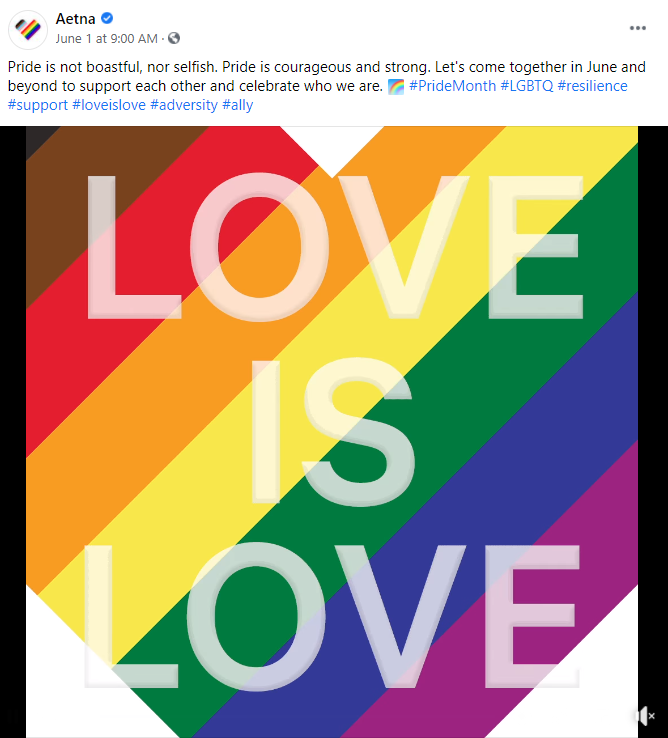
Providing information on how brands are taking action to support the LBTQ+ community beyond Pride Month may keep brands out of the hot seat.
As consumers continue to expect brand commitments to go beyond rainbow logos and social media posts, taking the extra step of providing both internal and external ongoing commitments upfront may allow participating brands to deliver more authentic messages.
Notably, Prudential took the opportunity to not only share its actions but also incorporate all pronouns, which is a prevalent topic within the LGBTQ+ community.

Wells Fargo improved its brand image and the financial lives of LGBTQ+ people.
Running Pride ads is, of course, a way for a brand to establish its reputation as caring and supportive. It can double as a way to get the word out about initiatives that support LGBTQ+ people too.
That was the case for Wells Fargo. The landing page of this ad brings people information about all sorts of diversity initiatives, including SAGECents, an app funded by Wells Fargo and made by advocacy group SAGE for older LGBTQ+ people to pursue financial wellness.

Visible made use of its name with the #ProudlyVisible campaign and encouraged engagement on social media.
With #ProudlyVisible, prepaid mobile carrier Visible (whose parent company is Verizon) asked people to share their definitions of family. That ties right into the carrier’s version of a family plan, called Party Pay, which lets people define their own families or parties.
#ProudlyVisible won’t end when the month does, according to Ad Age—and that’s crucial if it’s going to keep the conversation going.
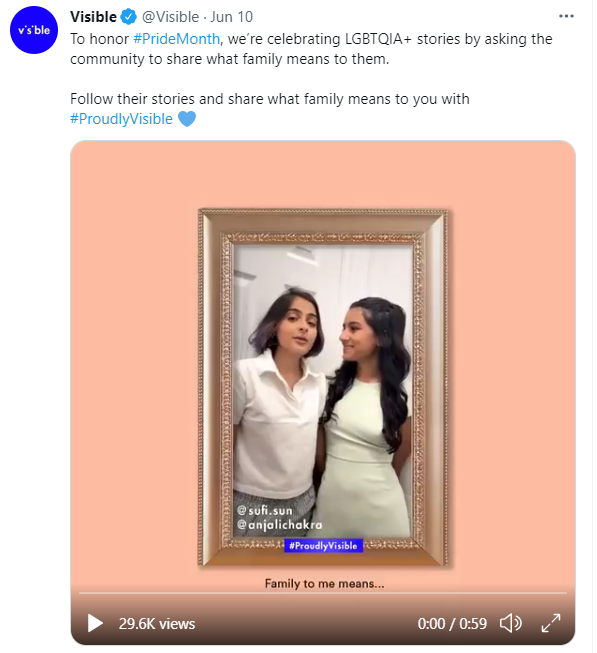
The Discover it Pride Card, available year-round, is one of many designs, putting the celebration on par with more trivial matters.
Discover has offered the card since 2015, showing its long-term commitment to making it easy to celebrate Pride with its products. Because Discover offers so many designs for the it card—including an American flag, flowers, and a cassette tape—offering a rainbow card could risk trivializing an entire group of identities. On the other hand, it makes those identities part of everyday life, thereby normalizing them, while at the same time making them visible.

Short-term commitments
Brands face a catch-22: If they don’t amp up Pride marketing during June, they might look like they don’t care about something that is, at this point, widely celebrated. But if they do suddenly start talking about Pride, it can come off as opportunistic. To get around this dilemma, brands should be forthright about their plans to continue their pledges and marketing beyond June. It doesn’t have to be the same marketing year-round, but it should be at least connected.
Canada Life focused inward to showcase its “come as you are” initiative by sharing employees’ personal perspectives.
In a similar fashion to Discover’s work from home campaign, which showcased its employees during COVID-19 on social media, Canada Life created its “come as you are” Instagram initiative. The Canadian insurer shared the true stories of real employees which put its commitment to equality on display but also allowed for positive representation to be seen throughout the LGBTQ+ community.
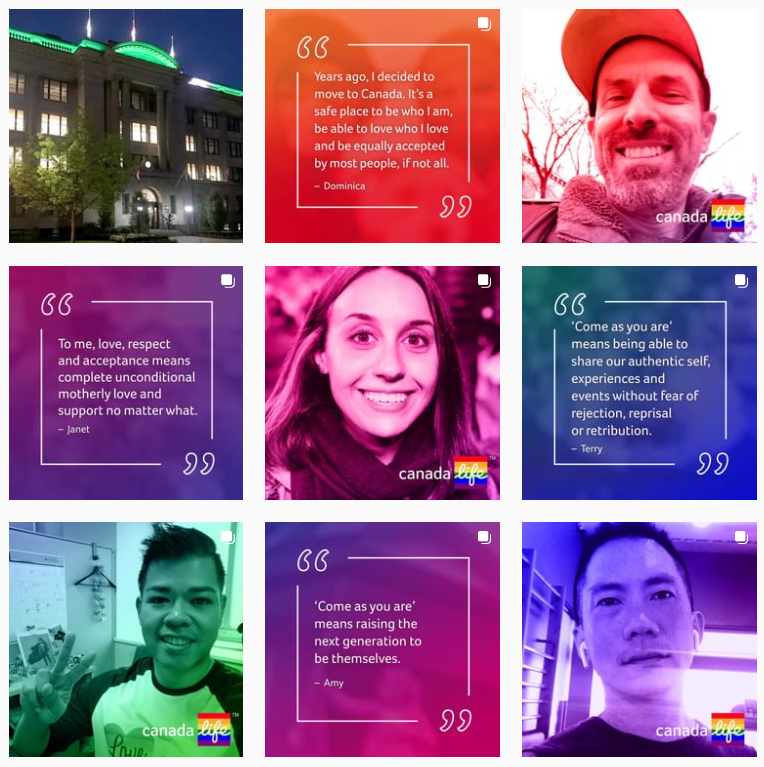
TD highlighted both its LGBTQ+ employees and its commitments outside the workplace for more inclusivity.
In a series of stories that it posts throughout the year, TD Bank made clear that it’s setting out to stand up for not just its outward-facing LGBTQ+ initiatives but for its employees too.

BMO brought together Toronto’s favorite drag queens to create a playlist in support of the Pride & Remembrance Run.
BMO Financial Group is this year’s Pride & Remembrance run Platinum Sponsor. The run, which has taken place for the last 25 years, is the only annual athletic event during Pride Week in Toronto. With the goal of bringing together the Canadian LGBT+ community, the mission is to remember the past in order to build on the future.
BMO activated its sponsorship by creating Spotify playlists, curated by Toronto’s favorite drag queens, to fuel the run with Pride-themed jams.
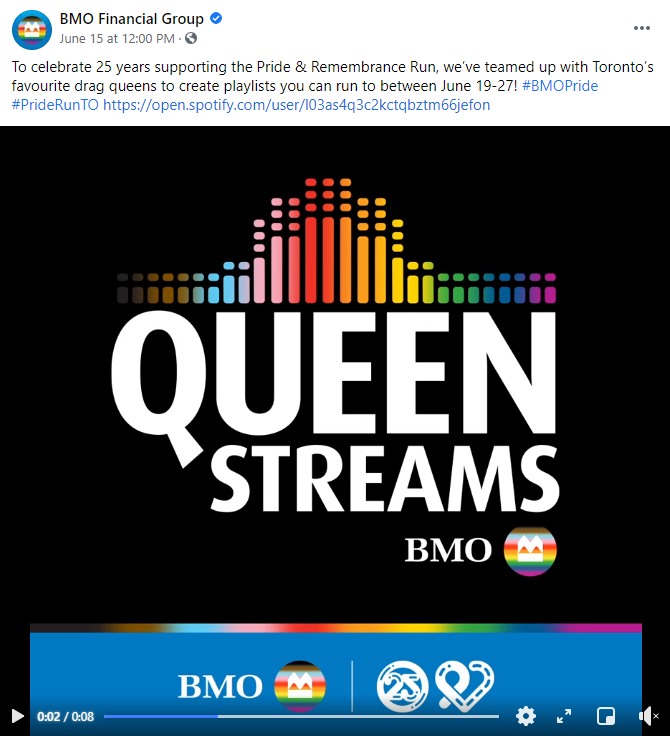
Brands shared their fiscal contributions and partnerships with LGBTQ+ organizations to show their support in action.
Brands incorporated their fiscal support and partnerships in owned social media posts to not only join the ongoing conversation around Pride, but to also demonstrate a true commitment to making meaningful change within the community.
Lemonade especially highlighted its partnership with The Trevor Project, which is a year-round relationship. The insurtech allows its members to contribute to the charity with unclaimed money from the year.
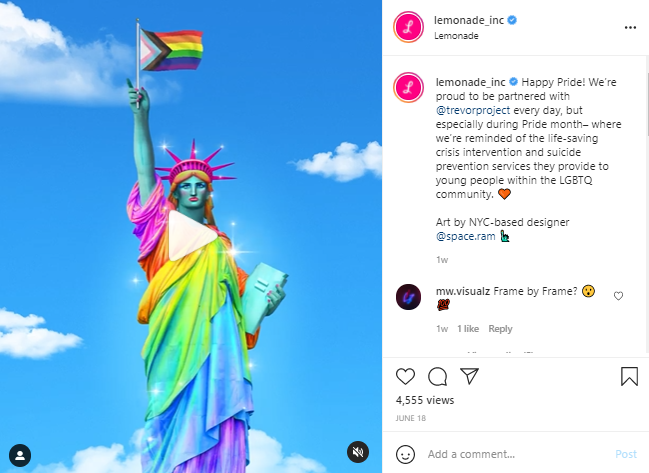
What to consider moving forward
With its exemplary strategy toward LGBTQ+ communities and content, Netflix provides inspiration for brands seeking consistency.
It’s one thing for a brand to consistently speak in support of the LGBTQ+ community beyond Pride Month, but it’s another to reflect that stance in actual products and services. By doing both, Netflix demonstrates its commitment to the community—and to standing up for and normalizing its values.
Brands looking to take a similar approach should consider how they can build LGBTQ+ support directly into their products to round out their marketing.

Nicole Bond is a Senior Research Analyst, interpreting cross-channel marketing and consumers trend with a focus in telecom and financial services. Nicole also has a Master’s in Integrated Marketing Communications from Northwestern University, contributing to her passion for identifying consumer drivers and helping clients develop omnichannel marketing strategies.
Rachel Arndt is a Research Manager leading a team of analysts who deliver reports across industries to support clients with competitive insights. Rachel also researches and writes about marketing and industry trends. Her first book, Beyond Measure, came out in 2018.
![[Series] Social responsibility amidst recovery: Black Lives Matter](https://welcome.comperemedia.com/wp-content/uploads/2020/07/CM_SocialMedia_SocialResponsibility_DeepPurple300_Blog_2000x1000.jpg)

